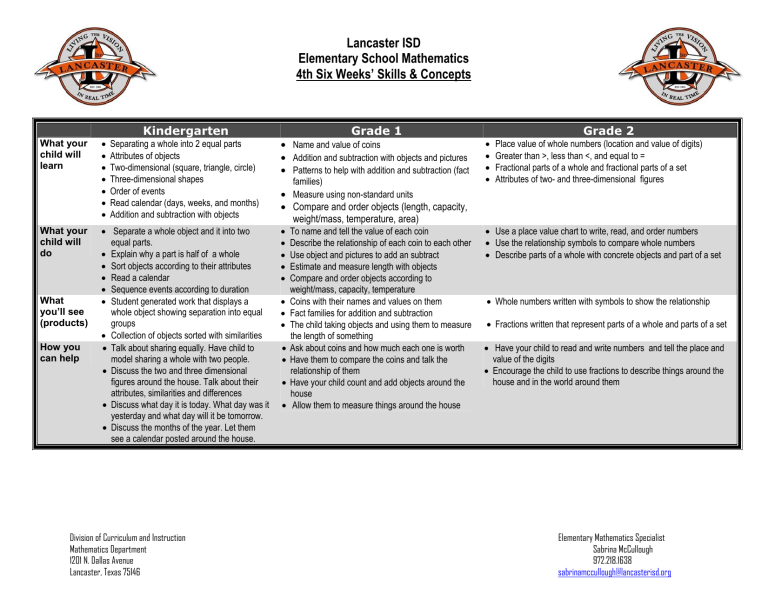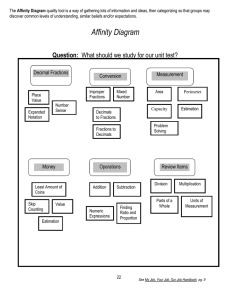Lancaster ISD Elementary School Mathematics 4th Six Weeks` Skills

Lancaster ISD
Elementary School Mathematics
4th Six Weeks’ Skills & Concepts
What your child will learn
What your child will do
What you’ll see
(products)
How you can help
Kindergarten
• Separating a whole into 2 equal parts
• Attributes of objects
• Two-dimensional (square, triangle, circle)
• Three-dimensional shapes
• Order of events
• Read calendar (days, weeks, and months)
• Addition and subtraction with objects
• Separate a whole object and it into two equal parts.
• Explain why a part is half of a whole
• Sort objects according to their attributes
• Read a calendar
• Sequence events according to duration
• Student generated work that displays a whole object showing separation into equal groups
• Collection of objects sorted with similarities
• Talk about sharing equally. Have child to model sharing a whole with two people.
• Discuss the two and three dimensional figures around the house. Talk about their attributes, similarities and differences
• Discuss what day it is today. What day was it yesterday and what day will it be tomorrow.
• Discuss the months of the year. Let them see a calendar posted around the house.
Grade 1
• Name and value of coins
• Addition and subtraction with objects and pictures
• Patterns to help with addition and subtraction (fact families)
• Measure using non-standard units
•
Compare and order objects (length, capacity, weight/mass, temperature, area)
• To name and tell the value of each coin
• Describe the relationship of each coin to each other
• Use object and pictures to add an subtract
• Estimate and measure length with objects
• Compare and order objects according to weight/mass, capacity, temperature
• Coins with their names and values on them
• Fact families for addition and subtraction
• The child taking objects and using them to measure the length of something
• Ask about coins and how much each one is worth
• Have them to compare the coins and talk the relationship of them
• Have your child count and add objects around the house
• Allow them to measure things around the house
Grade 2
• Place value of whole numbers (location and value of digits)
• Greater than >, less than <, and equal to =
• Fractional parts of a whole and fractional parts of a set
• Attributes of two- and three-dimensional figures
• Use a place value chart to write, read, and order numbers
• Use the relationship symbols to compare whole numbers
• Describe parts of a whole with concrete objects and part of a set
• Whole numbers written with symbols to show the relationship
• Fractions written that represent parts of a whole and parts of a set
• Have your child to read and write numbers and tell the place and value of the digits
• Encourage the child to use fractions to describe things around the house and in the world around them
Division of Curriculum and Instruction
Mathematics
1201 N. Dallas Avenue
Lancaster, Texas 75146
Elementary Mathematics Specialist
Sabrina
972.218.1638 sabrinamccullough@lancasterisd.org
Lancaster ISD
Elementary School Mathematics
4th Six Weeks’ Skills & Concepts
What your child will learn
What your child will do
What you’ll see
(products)
How you can help
Grade 3
• Fractions
• How to use measurement tools to measure in standard units
• How to use models and concrete objects to determine the area of two-dimensional surfaces
• Reading a thermometer
• Tell time using analog and digital clocks
• Construct models of fractions
• Construct models of equivalent fractions
• Use standard units to find the distance around an object
• Use a thermometer to measure temperature
• Tell and write time
• Pictorial representation of equivalent fractions
• Measurement tools being used
• Student generated work of analog clocks
• Allow them to use measurement tools around the house to measure objects
• Ask them what the temperature is during one part of the day. Ask them to tell you during another part of the day. Have them to find the difference.
Grade 4
• Place value of whole numbers and decimals
• Right, obtuse, and acute angles
• Attributes of two- and three- dimensional figures
• Reflection, rotation, and translation
• Symmetry
• Points on a number line
• Simple conversions
• Identify and describe angles
• Demonstrate transformations
• Locate and name points on a number line using numbers, fractions, and decimals
• Perform simple conversions
• Various objects that show the different angles
• Coordinator grips with objects that turn, flip, and slide
• Number lines with fractions and decimals located on there
• Conversion charts
• Talk about everyday objects and the angles that they form
• Have them take objects and perform a transformation
Grade 5
• Simple conversions
• Changes in temperature
• Formulas to use to solve problems
• Elapsed time
• To make predictions from experimental results
• Possible outcomes from probability experiments
• Mean, median, and mode
• Perform conversions within the same metric system
• Solve problems involving time and temperature
• Use data to create graphs
• Describe characteristics of data in tables
• Graph a set of data
• Conversion charts
• Word problems that involve elapsed time and temperature
• Tally marks, charts and graphs that represent the data of the experiments
• Talk about start and stop time of different events
• Talk about the temperature and how it changes throughout the day
Division of Curriculum and Instruction
Mathematics
1201 N. Dallas Avenue
Lancaster, Texas 75146
Elementary Mathematics Specialist
Sabrina
972.218.1638 sabrinamccullough@lancasterisd.org
